
BOSTON -- The biologic agents used to treat rheumatoid arthritis are no better or worse for the heart than methotrexate, according to a case-control study.

BOSTON -- The biologic agents used to treat rheumatoid arthritis are no better or worse for the heart than methotrexate, according to a case-control study.

WASHINGTON -- Vaccination against influenza or pneumococcal disease is safe and effective in people with rheumatoid arthritis who are taking Humira (adalimumab), a researcher said here.

WASHINGTON -- There is no link of significance between major cancers and new biologic therapies for rheumatoid arthritis, FDA-mandated warnings not withstanding, a researcher said here.

WASHINGTON -- Humira (adalimumab) has a "quite profound" benefit for children with juvenile rheumatoid arthritis and is well-tolerated, a researcher reported here.

WASHINGTON -- Early aggressive treatment with a combination of drugs can drive rheumatoid arthritis into drug-free remission in some patients, Dutch researchers said here.

TUCSON, Ariz. -- Joints affected by the inflammation of rheumatoid arthritis may be soothed by dietary supplements containing extracts of the curry ingredient turmeric, researchers here studying rats reported.

STANFORD, Calif. -- Gleevec (imatinib), the targeted leukemia drug, appears to prevent and reverse rheumatoid arthritis in a mouse model, researchers here reported, apparently by inhibiting proteins involved in inflammation.

STANFORD, Calif. -- Gleevec (imatinib), the targeted leukemia drug, appears to prevent and reverse rheumatoid arthritis in a mouse model, researchers here reported, apparently by inhibiting proteins involved in inflammation.

n epidemiologic studies, cigarette smoking is strongly associated with the development of rheumatoid arthritis (RA), in particular seropositive RA. In 1987, Vessey and colleagues1 first reported an unexpectedly elevated risk of RA among women smokers in the Oxford Family Planning Association contraceptive study.

SAN FRANCISCO -- Women with a strong genetic predisposition to rheumatoid arthritis aren't exacerbating the problem by smoking, surprised investigators here discovered.

SEATTLE -- Circulating fetal cells may account for why rheumatoid arthritis tends to improve or even disappear during pregnancy, according to researchers here.

AMSTERDAM ? Two-year data from the extension of a major trial of Orencia (abatacept) suggest that the agent continued to prevent the advance of structural damage in rheumatoid arthritis, researchers reported here.

Skin signs of systemic disease: sarcoidosis, rheumatoid nodules, Muir-Torre syndrome, diabetic vasculopathy, hyperlipidemic nodules, zinc deficiency, and Sister Mary Joseph nodule.
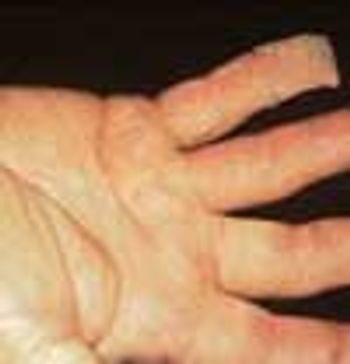
This contorted hand of a 49-year-old man demonstrates Dupuytren's contracture, a disorder first described by Baron Guillaume Dupuytren in 1831. Although the condition may occur as a completely independent abnormality, it is commonly associated with chronic liver disease, diabetes mellitus, epilepsy, palmar fasciitis, carpal tunnel syndrome, rheumatoid arthritis, pulmonary tuberculosis, and alcoholism. This patient had a history of alcohol abuse.
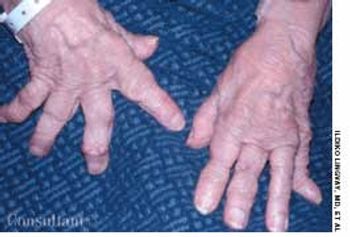
A 76-year-old woman had a 40-year history of rheumatoid arthritis (RA). She had repeatedly refused treatment with disease-modifying drugs, including methotrexate. Nodules began to develop 15 years after the initial diagnosis; they recurred after surgical removal.

The use of preserved artificial tears several times a day provided little relief to this 54-year-old woman with red and painful eyes. The patient had a history of rheumatoid arthritis and dry eye syndrome; the latter is very common in patients with rheumatoid arthritis.
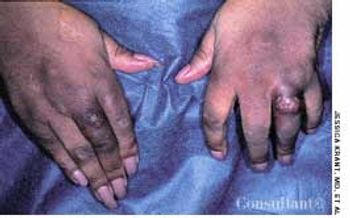
A 65-year-old woman, who was confined to a wheelchair because of severe rheumatoid arthritis, was concerned about nodules that had erupted on her fingers and hands during the previous 3 weeks. Her medical history included colon cancer, chronic renal insufficiency, anemia, and hypertension. The nonpruritic nodules were painful when they began to form under the skin; however, once they erupted, the pain disappeared.
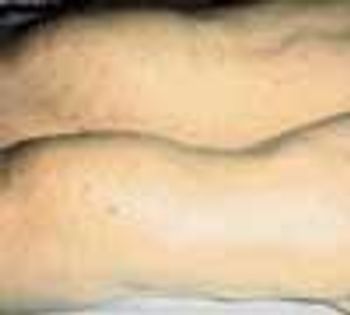
A variety of rheumatic diseases-systemic lupus erythematosus (SLE), rheumatoid arthritis (RA), and the vasculitides among them-manifest as “lumps, bumps, and holes” involving the extremities. Each of these diseases works through specific mechanisms on different structures of the skin to produce a distinctive pathology. In doing so, each provides clues to the cause, which the history and physical examination can help confirm.

This 64-year-old woman has had rheumatoid arthritis for 15 years; her hands show classic rheumatic changes. She also had a leg ulcer that had failed to heal in 8 years despite three skin grafts.
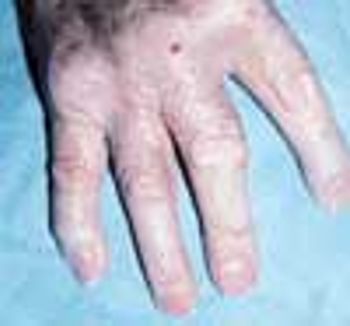
Various types of cutaneous lesions may occur in association with RA, including rheumatoid nodules, rheumatoid neutrophilic dermatitis, vasculitis, palpable purpura, and pyoderma gangrenosum. Many of these manifestations-including rheumatoid nodules-are specific for RA. The presence of these nodules is associated with seropositive disease and with a more severe, erosive clinical presentation. The nodules appear in 20% to 30% of patients with RA. Sites of predilection are those subject to shear stress, including the subcutaneous tissues over the extensor aspects of the elbow region, over the sacrum in bedridden persons, and at the pericardial and pleural surfaces.
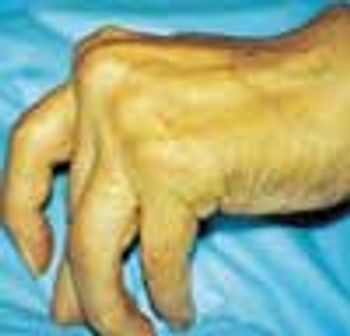
This 60-year-old man has had rheumatoid arthritis (RA) for 40 years. Typical of progressive, long-standing disease is the deformity seen here in his hands and feet.
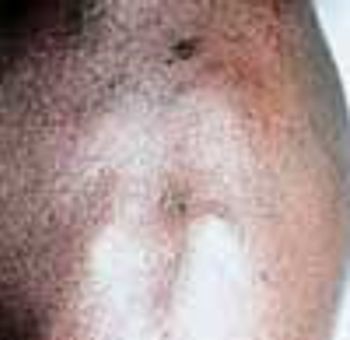
Cutaneous and subcutaneous lesions of the extremities may be clues to the presence of rheumatic diseases such as systemic lupus erythematosus (SLE), rheumatoid arthritis (RA), and the vasculitides. The history and physical examination can generally help confirm the cause. Skin biopsy is sometimes necessary for a definitive diagnosis; useful results depend on a technique that gives the depth necessary to see the pathology and proper interpretation of biopsy specimens by an experienced dermatopathologist.
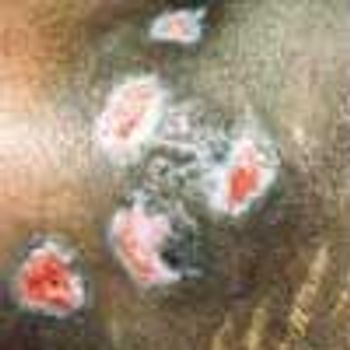
Pyoderma gangrenosum (PG) is a chronic, recurrent condition characterized by cutaneous ulceration. In half of patients, PG is associated with an underlying illness, such as inflammatory bowel disease, RA, SLE, or a lymphoproliferative disorder.
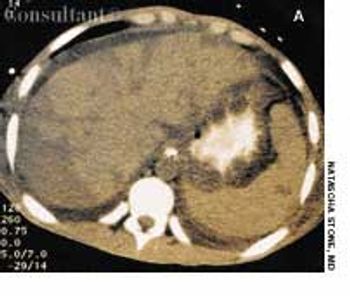
Systemic lupus erythematosus (SLE) was diagnosed in an 18-year-old man who presented with polyarthritis, fever, hypoxia, fatigue, anemia, neutropenia, and abnormal urinary sediment. A renal biopsy showed diffuse mesangial proliferative glomerulonephritis (World Health Organization class II). Serologic tests were positive for fluorescent antinuclear antibody (FANA), SS-A, SS-B, anti-Sm and anti-dsDNA antibodies, and rheumatoid factor; a direct Coombs' test result was positive as well.

ABSTRACT: Early treatment with disease-modifying anti-rheumatic drugs (DMARDs)--alone or in combination-- can prevent joint damage and minimize disability. Until recently, the DMARDs used predominantly in patients with rheumatoid arthritis had been methotrexate, sulfasalazine, and hydoxychloroquine. Older DMARDs such as gold, d-penicillamine, and azathioprine have fallen out of favor because of their long- term toxicities or modest benefit. Six newer DMARDs--leflunomide, etanercept, infliximab, adalimumab, rituximab, and anakinra--have greatly expanded the current treatment options.